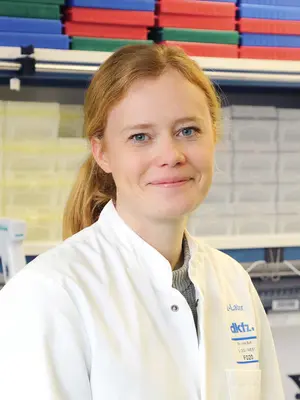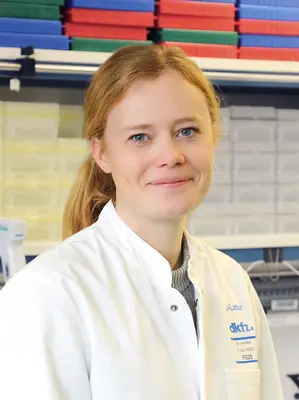Projects
Human Papillomavirus antibodies and risk of subsequent head and neck cancer

HPV is known for causing cervical cancer, but it also causes large proportions of other anogenital cancers (anal, vaginal, vulva, penis) and head and neck, especially oropharyngeal cancer (OPC) comprising mostly cancer of the palatine tonsils and the base of tongue.
OPC is rare, but shows strongly increasing incidence rates in many countries. The "classical" risk factors tobacco and alcohol have been superseded by HPV in the US and some European countries (e.g. UK, Sweden), where more than 70% of OPC are attributable to HPV, predominantly type 16 (HPV16). In these countries, the number of men with HPV-driven OPC (HPV-OPC) already exceeds the number of women with cervical cancer. This is a paradigm shift for HPV, and requires entirely new public health interventions, given low HPV vaccination rates, especially among boys. Although HPV-OPC is characterized by favorable survival, diagnosis typically occurs after the primary tumor has metastasized to the neck, often necessitating the use of multimodality treatment which may result in severe treatment-related morbidity, such as speech and swallowing dysfunction. To date, no precursor lesion for OPC has been identified making early detection challenging.
Serum antibodies against HPV16 proteins, especially the oncoprotein E6, are promising biomarkers for identifying individuals at risk for HPV-OPC development. HPV16 E6 antibodies have been shown to be present in approximately 90% of HPV-OPC patients at the time of diagnosis, with a specificity of 99%, and are detectable more than ten years prior to diagnosis. HPV16 E6 seroprevalence in the general population and in cancer-free controls is about 0.5%, making HPV16 E6 seropositivity a promising biomarker to develop an efficient screening strategy for early detection of HPV-OPC. The 5-year risk of a 60-year old HPV16 E6 seropositive male to develop HPV-OPC has been estimated at >14% (>27% after 10 years), reflecting a positive predictive value (PPV) exceeding that of established screening methods for e.g. cervical, breast or colorectal cancer.
1. Kreimer AR, Johansson M, Waterboer T, Kaaks R,…, Hildesheim A, Boeing H, Pawlita M, Brennan P. Evaluation of human papillomavirus antibodies and risk of subsequent head and neck cancer. J Clin Oncol. 2013 Jul 20;31(21):2708-15.
2. Kreimer AR, Johansson M, Yanik EL, Katki HA,…, Michel A, Pawlita M, Brennan P, Waterboer T. Kinetics of the Human Papillomavirus Type 16 E6 Antibody Response Prior to Oropharyngeal Cancer. J Natl Cancer Inst. 2017 Aug 1;109(8):djx005.
3. Kreimer AR, Ferreiro-Iglesias A, Nygard M, Bender N,…, Freedman ND, Brennan P, Waterboer T, Johansson M. Timing of HPV16-E6 antibody seroconversion before OPSCC: findings from the HPVC3 consortium. Ann Oncol. 2019 Aug 1;30(8):1335-1343.
4. Hibbert J, Halec G, Baaken D, Waterboer T, Brenner N. Sensitivity and Specificity of Human Papillomavirus (HPV) 16 Early Antigen Serology for HPV-Driven Oropharyngeal Cancer: A Systematic Literature Review and Meta-Analysis. Cancers (Basel). 2021 Jun 16;13(12):3010.
5. Robbins HA, Ferreiro-Iglesias A, Waterboer T, Brenner N,…, Freedman ND, Kreimer AR, Johansson M, Brennan P. Absolute Risk of Oropharyngeal Cancer After an HPV16-E6 Serology Test and Potential Implications for Screening: Results From the Human Papillomavirus Cancer Cohort Consortium. J Clin Oncol. 2022 Nov 1;40(31):3613-3622.
The Hamburg HPV Oropharyngeal Cancer Screening Study (PHORECAST)

The incidence of oropharyngeal cancer attributable to human papillomaviruses (HPV-OPC) has been rising constantly over the last decades. How oral HPV infections progress into cancer is poorly understood, and the lack of detectable precancerous lesions makes early detection of HPV-OPC difficult. Antibodies to HPV16 early proteins, especially E6, are strongly associated with HPV-OPC at the time of, but also prior to diagnosis1,2.
Within the Hamburg City Health Study (HCHS), a prospective, epidemiologic cohort study, we measured HPV serum antibodies in 5,000 participants enrolled 2016-2017 (men and women of the general population of the city of Hamburg aged 45-74 years) and identified eleven individuals with a high-risk antibody profile for the development of HPV-OPC. These individuals were invited to regular 6-monthly, non-invasive head and neck examinations in 2019 to diagnose HPV-OPC as early as possible. Within 1.3 years of clinical follow-up, three individuals were diagnosed with asymptomatic stage I HPV-OPC.3 The study is ongoing and since publication of the first three cases, two additional HPV-OPC cases were diagnosed resulting in a PPV of ~40% within 3.5 years of follow-up.
We are currently extending this screening approach to the next ~18,000 HCHS participants enrolled 2017-2025, with additional clinical examinations and a more comprehensive panel of biomarkers in order to describe the combination that maximizes the positive predictive value for HPV-OPC.4 HPV serology-based screening may facilitate early detection of HPV-OPC and thus reduce treatment-related morbidity.
1. Kreimer AR, Johansson M, Waterboer T, Kaaks R,…, Hildesheim A, Boeing H, Pawlita M, Brennan P. Evaluation of human papillomavirus antibodies and risk of subsequent head and neck cancer. J Clin Oncol. 2013 Jul 20;31(21):2708-15.
2. Kreimer AR, Ferreiro-Iglesias A, Nygard M, Bender N,…, Freedman ND, Brennan P, Waterboer T, Johansson M. Timing of HPV16-E6 antibody seroconversion before OPSCC: findings from the HPVC3 consortium. Ann Oncol. 2019 Aug 1;30(8):1335-1343.
3. Busch CJ, Hoffmann AS, Viarisio D, Becker BT…, Lang Kuhs K, Pawlita M, Waterboer T, Brenner N. Detection of stage I HPV-driven oropharyngeal cancer in asymptomatic individuals in the Hamburg City Health Study using HPV16 E6 serology - A proof-of-concept study. EClinicalMedicine. 2022 Sep 17;53:101659.
4. Robbins HA, Ferreiro-Iglesias A, Waterboer T, Brenner N,…, Freedman ND, Kreimer AR, Johansson M, Brennan P. Absolute Risk of Oropharyngeal Cancer After an HPV16-E6 Serology Test and Potential Implications for Screening: Results From the Human Papillomavirus Cancer Cohort Consortium. J Clin Oncol. 2022 Nov 1;40(31):3613-3622.
Human papillomavirus cell-free DNA in liquid biopsies for cancer screening and post-therapy monitoring

In recent years, many high-income countries have seen a strong and steady increase in Human Papillomavirus (HPV)-driven oropharyngeal cancer (OPC). Even though HPV-driven OPC has a better prognosis than HPV-negative (i.e., mostly smoking-driven) OPC, treatment often comes with severe long-term side effects for the patient, and disease recurrence can be fatal. In order to improve patient outcomes after HPV-driven OPC therapy, HPV cell-free DNA (cfDNA) from blood plasma may be a useful biomarker to predict recurrence of the disease.
To improve sensitivity and specificity of HPV DNA detection from various biomaterials, we have developed a multiplex digital PCR assay that targets multiple HPV types involved in HPV-driven cancers, and investigate test performance in different settings. We have shown that HPV cfDNA is detectable at time of diagnosis in HPV-driven OPC with high sensitivity and specificity, and that recurrence of the disease can be detected months before diagnosis1,2.
Previous work by our group has shown that antibodies against the HPV16 E6 oncoprotein are a very sensitive and specific biomarker for HPV-driven OPC, but since they can be present decades before diagnosis this is primarily useful to estimate the long-term risk of developing HPV-OPC. For personalized risk prediction, an additional marker that provides a more short-term indication of tumor formation is necessary. Our goal is therefore to detect HPV cfDNA before diagnosis and to assess its dynamics before onset of disease to determine its potential as a biomarker for HPV-OPC screening.
1. Rosing F, Meier M, Schroeder L, Laban S,…, Alt Y, Faden DL, Waterboer T, Höfler D. Quantification of human papillomavirus cell-free DNA from low-volume blood plasma samples by digital PCR. Microbiol Spectr. 2024 Jul 2;12(7):e0002424
2. Rosing F, Plath M, Proctor T, Höfler D,…, Waterboer T, Hess J, Plath K, Schroeder L. Post-treatment monitoring of surgically treated oropharyngeal squamous cell carcinoma patients using human papillomavirus cell-free DNA. Oral Oncology. 2025
Helicobacter pylori and gastrointestinal cancer

Cancer of the stomach accounted for almost 1 million new cancer cases in 2022 worldwide. The major risk factor for development of stomach cancer is an infection with the bacterium Helicobacter pylori (H. pylori), and antibiotic treatment of infected individuals was shown to be effective in gastric cancer prevention. Our research group has developed a multiplex serology assay1 which is applied in multiple epidemiological studies with collaboration partners from all over the world. The results provide insights into the H. pylori prevalence in different populations/regions in the world,2,3,4 its associations with cancer, 5,6 also in other entities than the stomach,7 as well as biomarkers that may identify individuals with high risk of developing H. pylori-associated gastric cancer.8 The assay is under constant refinement to meet the current status of research, not only with respect to additional H. pylori antigens of interest,9 but also other biomarkers relevant for stomach cancer, including autoantibodies.6
1. Michel A, Waterboer T, Kist M, Pawlita M. Helicobacter multiplex serology. Helicobacter. 2009 Dec;14(6):525-35
2. Yao P, Millwood I, Kartsonaki C, Mentzer AJ,…G, Li LM, Waterboer T, Yang L, Chen Z. Sero-prevalence of 19 infectious pathogens and associated factors among middle-aged and elderly Chinese adults: a cross-sectional study. BMJ Open. 2022 May 9;12(5):e058353
3. Varga MG, Butt J, Blot WJ, Le Marchand L,…, Hildesheim A, Waterboer T, Pawlita M, Epplein M. Racial Differences in Helicobacter pylori CagA Sero-prevalence in a Consortium of Adult Cohorts in the United States. Cancer Epidemiol Biomarkers Prev. 2020 Oct;29(10):2084-2092
4. Wawro N, Amann U, Butt J, Meisinger C,…, Rathmann W, Kääb S, Waterboer T, Linseisen J. Helicobacter pylori Seropositivity: Prevalence, Associations, and the Impact on Incident Metabolic Diseases/Risk Factors in the Population-Based KORA Study. Front Public Health. 2019 Apr 24;7:96
5. Yao P, Kartsonaki C, Butt J, Jeske R,…, Waterboer T, Chen Z, Millwood IY, Yang L. Helicobacter pylori multiplex serology and risk of non-cardia and cardia gastric cancer: a case-cohort study and meta-analysis. Int J Epidemiol. 2023 Aug 2;52(4):1197-1208
6. Butt J, Lehtinen M, Öhman H, Waterboer T, Epplein M. Association of Helicobacter pylori and Autoimmune Gastritis With Stomach Cancer in a Cohort of Young Finnish Women. Gastroenterology. 2022;163(1):305-307 e4.
7. Butt J, Varga MG, Blot WJ, Teras L,…, Hildesheim A, Waterboer T, Pawlita M, Epplein M. Serologic Response to Helicobacter pylori Proteins Associated With Risk of Colorectal Cancer Among Diverse Populations in the United States. Gastroenterology. 2019;156(1):175–186.e2.
8. Epplein M, Butt J, Zhang Y, Hendrix LH,…, Waterboer T, Pawlita M, You WC, Pan KF. Validation of a blood biomarker for identification of individuals at high risk for gastric cancer. Cancer Epidemiol Biomarkers Prev. 2018 Dec;27(12):1472-1479.
9. Jeske R, Reininger D, Turgu B, Brauer A,…, Waterboer T, Butt J, Aragonés N, Hufnagel K. Development of Helicobacter pylori Whole-Proteome Arrays and Identification of Serologic Biomarkers for Noncardia Gastric Cancer in the MCC-Spain Study. Cancer Epidemiol Biomarkers Prev. 2020 Nov;29(11):2235-2242
Diagnostic assays for Epstein-Barr virus associated cancers

Epstein-Barr virus (EBV) is a ubiquitous human herpesvirus infecting >90% of adults worldwide. While most carriers remain asymptomatic, EBV has been linked with the development of various malignancies, including nasopharyngeal carcinoma (NPC), Hodgkin lymphoma, Burkitt's lymphoma, and gastric cancer (GC). In addition, recent studies have strengthened the associations between EBV and neurodegenerative diseases, notably multiple sclerosis.
In regions where EBV-driven cancers such as NPC are endemic, screening methods typically involve detection of antibodies against the viral capsid antigen (VCAp18) and Epstein-Barr nuclear antigen 1 (EBNA-1). To develop a better understanding of EBV antibody signatures in NPC, we have developed a panel of 23 EBV antigens, assessing both IgA and IgG antibodies. Notably, IgG antibodies targeting LF2 - a previously overlooked switch protein in the B95-8 strain of EBV - and BGLF2, a late lytic tegument protein, have demonstrated the ability to distinguish EBV-driven NPC cases from controls with >90% accuracy in both endemic and non-endemic regions (1, 2, 3). This panel is also used to identify distinct antibody signatures in EBV-associated gastric cancer which constitutes approximately 8% of all gastric cancer cases. Additionally, the panel will also be tested in patients with ocular cancers and multiple sclerosis to explore EBV involvement and secondary prevention options.
For causality assessment in etiological studies, identification of EBV-driven tumors relies on Epstein-Barr encoded RNA in situ hybridization (EBER-ISH), a technique that visualizes EBER1/2 RNA within the nuclei of cancerous cells. While EBER-ISH is crucial for confirming EBV presence, it does not provide quantitative data or prognostic information. To address this limitation, we are developing quantitative reverse transcription PCR assays (qRT-PCR) aimed at detecting and quantifying coding and non-coding EBV RNA transcripts which could provide etiological and prognostic information. We also target specific single nucleotide variants linked to higher-risk EBV subtypes in NPC, thereby complementing existing diagnostic methods and offering comprehensive insights into EBV-related oncogenesis.
1. Simon J, Brenner N, Reich S, Langseth H,…, Johansson M, Pring M, Nygard M, Waterboer T. Nasopharyngeal carcinoma patients from Norway show elevated Epstein-Barr virus IgA and IgG antibodies prior to diagnosis. Cancer Epidemiol. 2022 Apr;77:102117.
2. Simon J, Schroeder L, Ingarfield K, Diehl S,…, Pring M, Butt J, Ness A, Waterboer T. Epstein-Barr virus and human papillomavirus serum antibodies define the viral status of nasopharyngeal carcinoma in a low endemic country. Int J Cancer. 2020 Jul 15;147(2):461-471.
3. Simon J, Liu Z, Brenner N, Yu KJ,…, Proietti C, Doolan DL, Hildesheim A, Waterboer T. Validation of an Epstein-Barr virus antibody risk stratification signature for nasopharyngeal carcinoma by use of multiplex serology. J Clin Microbiol. 2020 Apr 23;58(5):e00077-20.
Unmasking infection-driven cancers

Understanding whether a cancer is causally driven by an infectious agent requires more than identifying the presence of a virus or bacterium. To confirm biological activity of the pathogen, detection of active gene expression within cancer tissue is needed. My research projects focus on highly sensitive methods to detect DNA and, more importantly, RNA. The presence of specific RNA transcription patterns of an active infection provides essential insights into cancer etiology.
Cancer tissue specimens are most often preserved as formalin-fixed, paraffin-embedded (FFPE) samples resulting in a particular challenge: The nucleic acids are often fragmented and degraded. Consequently, our lab-developed PCR assays are designed to target very short amplicons, maintaining sensitivity and specificity.
- HPV E6*I DNA and RNA assays were designed and applied to multiple studies to estimate the fraction of HPV-driven head and neck 1,2,3 and anogenital cancers worldwide 4,5,6, or to investigate the role of HPV in different cancer types 7,8.
- EBV DNA and RNA assays were developed to define expression profiles in nasopharyngeal carcinoma, and to investigate the role of EBV in gastric cancer 9.
- H. pylori DNA and RNA assays are currently in validation and will be used to explore its role in gastrointestinal malignancies.
Due to the high sensitivity of our assays, every step of the workflow is standardized 10 from tissue sectioning to nucleic acid extraction, PCR amplification, and detection by e.g. qPCR, dPCR, and Luminex-based multiplex hybridization assays. This minimizes the risk of false positives due to sample cross-contamination, and ensures reproducible, reliable results.
1. Castellsagué X, Alemany L, Quer M, Halec G,…, Pawlita M, Muñoz N, de Sanjosé S, Xavier Bosch F; ICO International HPV in Head and Neck Cancer Study Group. HPV Involvement in Head and Neck Cancers: Comprehensive Assessment of Biomarkers in 3680 Patients. J Natl Cancer Inst. 2016 Jan 28;108(6):djv403.
2. Halec G, Holzinger D, Schmitt M, Flechtenmacher C,…, Lloveras B, Höfler D, Bosch FX, Pawlita M. Biological evidence for a causal role of HPV16 in a small fraction of laryngeal squamous cell carcinoma. Br J Cancer. 2013 Jul 9;109(1):172-83.
3. Nibu KI, Oridate N, Saito Y, Roset M,…, Mirghani H, Giuliano AR, Pavón MA, Waterboer T. Human papillomavirus-driven head and neck cancers in Japan during 2008-2009 and 2018-2019: The BROADEN study. Cancer Sci. 2024 Aug;115(8):2808-2818.
4. Halec G, Alemany L, Quiros B, Clavero O, Höfler D, Alejo M, Quint W, Pawlita M, Bosch FX, de Sanjose S. Biological relevance of human papillomaviruses in vulvar cancer. Mod Pathol. 2017 Apr;30(4):549-562.
5. Alemany L, Cubilla A, Halec G, Kasamatsu E,…, Pawlita M, Muñoz N, Bosch FX, de Sanjosé S; HPV VVAP study group. Role of Human Papillomavirus in Penile Carcinomas Worldwide. Eur Urol. 2016 May;69(5):953-61.
6. de Sanjosé S, Serrano B, Tous S, Alejo M,…, Pawlita M, Muñoz N, Bosch FX, Alemany L; RIS HPV TT, VVAP and Head and Neck study groups. Burden of Human Papillomavirus (HPV)-Related Cancers Attributable to HPVs 6/11/16/18/31/33/45/52 and 58. JNCI Cancer Spectr. 2019 Jan 7;2(4):pky045.
7. Halec G, Schmitt M, Egger S, Abnet CC,…, Urban MI, Waterboer T, Pawlita M, Sitas F; InterSCOPE Collaboration. Mucosal alpha-papillomaviruses are not associated with esophageal squamous cell carcinomas: Lack of mechanistic evidence from South Africa, China and Iran and from a world-wide meta-analysis. Int J Cancer. 2016 Jul 1;139(1):85-98.
8. Guimerà N, Alemany L, Halec G, Pawlita M,…, Jenkins D, de Sanjosé S, Quint W, Bosch FX. Human papillomavirus 16 is an aetiological factor of scrotal cancer. Br J Cancer. 2017 Apr 25;116(9):1218-1222.
9. Schieber J, Simon J, Vaas J, Babi A, Pring M,…, Delecluse S, Schroeder L, Waterboer T and Höfler D. Epstein-Barr virus RNA in nasopharyngeal carcinoma tissue detected by a novel multiplex RT-qPCR. In preparation.
10. Morais E, Kothari S, Chen YT, Roberts CS,…, Mehanna H, Giuliano AR, Mirghani H, Alemany L. The BROADEN study: The design of an observational study to assess the absolute burden of HPV-related head and neck cancers. Contemp Clin Trials. 2022 Apr;115:106631.
China Kadoorie Biobank (CKB) and UK Biobank (UKB)

We have successfully analyzed several large pilot studies comprising between 1000 and 10,000 serum samples from the China Kadoorie Biobank (CKB) and the UK Biobank (UKB). These studies have covered different disease entities and population subgroups, from nasopharynx cancer and various gastrointestinal cancers to general population samples. Recently, we have completed the analysis of 40,000 serum samples from the China Kadoorie Biobank (CKB) covering all 30,000 cancer cases diagnosed so far, and 10,000 subcohort samples. The Multiplex Serology panel contained antigens from 17 different pathogens, including Human Papillomaviruses, Human Herpesviruses, Human Polyomaviruses, Helicobacter pylori, Chlamydia trachomatis and others. The next project in our pipeline includes 50,000 samples from the UK Biobank (UKB).
1. Mentzer AJ, Brenner N, Allen N, Littlejohns TJ, …, UKB Infection Advisory Board; Collins R, Hill AVS, Waterboer T. Identification of host-pathogen-disease relationships using a scalable multiplex serology platform in UK Biobank. Nat Commun. 2022 Apr 5;13(1):1818
2. Chong AY, Brenner N, Jimenez-Kaufmann A, Cortes A,…, Moreno-Estrada A, Waterboer T, Hill AVS, Mentzer AJ. A common NFKB1 variant detected through antibody analysis in UK Biobank predicts risk of infection and allergy. Am J Hum Genet. 2024 Feb 1;111(2):295-308
3. Yao P, Millwood I, Kartsonaki C, Mentzer AJ,.…, Li LM, Waterboer T, Yang L, Chen Z. Sero-prevalence of 19 infectious pathogens and associated factors among middle-aged and elderly Chinese adults: a cross-sectional study. BMJ Open. 2022 May 9;12(5):e058353
4. Yao P, Kartsonaki C, Butt J, Jeske R,…, Waterboer T, Chen Z, Millwood IY, Yang L. Helicobacter pylori multiplex serology and risk of non-cardia and cardia gastric cancer: a case-cohort study and meta-analysis. Int J Epidemiol. 2023 Aug 2;52(4):1197-1208
5. Kartsonaki C, Yao P, Butt J, Jeske R,…, Waterboer T, Chen Z, Millwood IY, Yang L. Infectious pathogens and risk of esophageal, gastric and duodenal cancers and ulcers in China: A case-cohort study. Int J Cancer. 2024 Apr 15;154(8):1423-1432
6. Yang L, Kartsonaki C, Simon J, Yao P,…, Li L, Millwood IY, Waterboer T, Chen Z. Prospective evaluation of the relevance of Epstein-Barr virus antibodies for early detection of nasopharyngeal carcinoma in Chinese adults. Int J Epidemiol. 2024 Jun 12;53(4):dyae098
SARS-CoV-2 serolomics

We are only at the beginning of understanding the epidemiology of the worldwide COVID-19 pandemic. Assessing SARS-CoV-2 seroprevalence in large population-based studies, the evolution of antibody development over time after natural infection and/or vaccination, secondary attack rates after household infection, or the importance of antibodies to non-structural proteins, is of high importance to better understand outcomes such as acute disease severity, re-infection, or the occurrence of Long COVID.
We developed a multiplex serology assay covering almost the entire SARS-CoV-2 proteome (SARS-CoV-2 serolomics). Seropositivity to structural proteins N and S1-RBD yielded sensitivities and specificities of both 100% in detecting COVID-19 positive patients 14 days after symptom onset in a German hospital-based study.1 This assay is currently applied in multiple studies of national and international collaborations to answer the above-mentioned open questions. The multiplex ability of this assay moreover allows including antigens of different SARS-CoV-2 variants of concern, human "common cold" coronaviruses, and other pathogens including human herpesviruses that have been hypothesized to affect long-term outcomes of COVID-19 disease.
To allow for efficient high-throughput analyses of COVID-19 epidemiological studies, the SARS-CoV-2 serolomics assay will be integrated into a recently established automated workflow.
1. Butt J, Murugan R, Hippchen T, Olberg S,…, Schöttker B, Müller B, Merle U, Waterboer T. From Multiplex Serology to Serolomics-A Novel Approach to the Antibody Response against the SARS-CoV-2 Proteome. Viruses. 2021 Apr 24;13(5):749.